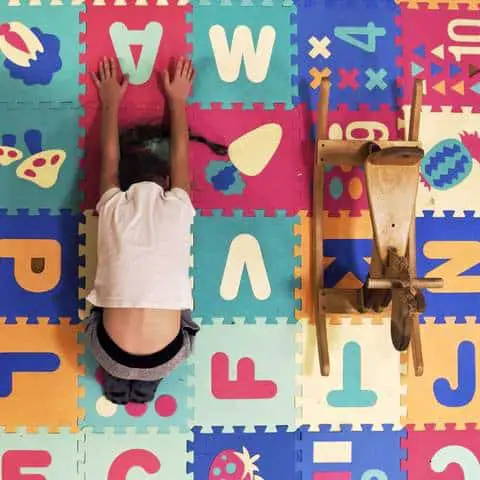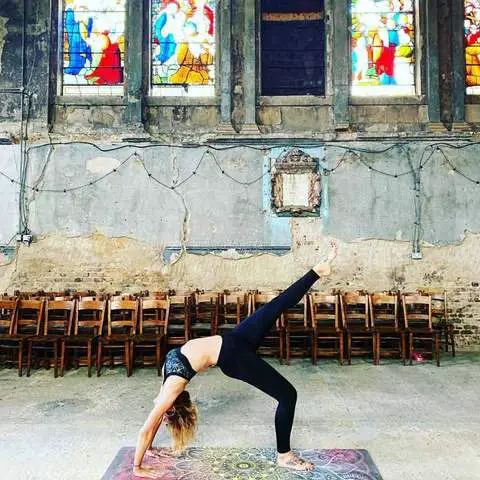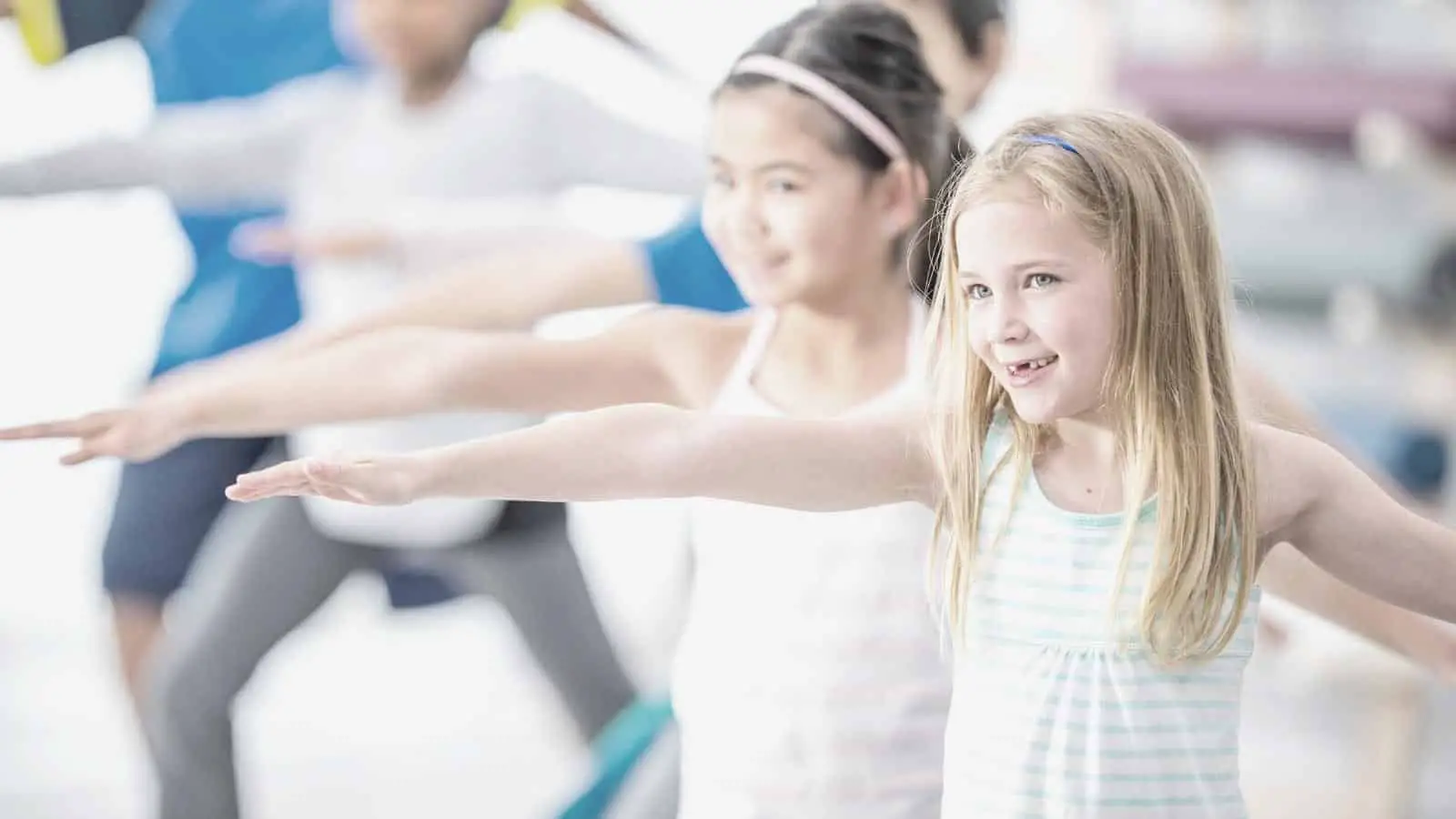How old should someone be before they can start yoga? A more accurate question may be, how young can one begin kids yoga?
In truth, there is no age constraint as to when an individual can begin a yoga practice. It seems that more and more adults are discovering the practice. They are finding new studios opening in their neighborhoods, and more gyms are offering classes for the health-conscious person. It seems, though, that when an adult starts practicing yoga, a common remark is, “Why didn’t I start this sooner?” These yogis are certainly experiencing the benefits of the practice and see how it may have helped them when they were younger.
What are they gaining? Physically, adult yoga practitioners are developing greater strength, flexibility, and mobility. Mentally, they are finding more clarity in their thinking, and emotionally, they are feeling calmer and less stressed. Wouldn’t these things be beneficial to a younger person, too? Absolutely!
Yoga is for everyone, even young people. Young kids and teenagers can reap the benefits of practicing yoga
It can be very good for the physically developing person as well as act as a resource for relieving stress and gaining mental awareness. These may sound like sophisticated topics, ones that may seem overwhelming to a child. But these concepts can be taught through kid-friendly approaches in age-appropriate yoga classes.
When Should a Child Begin Kids Yoga?
A young girl or boy can start yoga in the pre-school age years: 4 or 5 years old (even earlier if at home one of parents is yogi). As they are in these early developmental stages, some important lessons can be learned. One cannot be too young to learn how to get along with others, to have more emotional awareness, to appreciate their own bodies, and to boost their self-esteem. In a yoga class, especially designed for kids, these beneficial concepts can be taught and achieved.
In a Kids Yoga Class, the language and dynamic of the structure is much different from that of an adult-focused practice.
In Kids Yoga, carefully trained instructors use specific age-appropriate language that resonates with children, games are played to teach specific lessons, and an atmosphere of fun is attained.
An area of focus that can be practiced in a kids yoga class is emotional self-regulation.
This can be an important lesson for kids because it teaches them how to manage their emotions when they feel overwhelmed.

Socially, a child may learn how to manage anxious feelings, for example, if they are around adults that also practice self-regulation. These mirroring practices during development may include taking deep breaths to calm nerves, speaking quietly and calmly, or sitting still in a comfortable chair until the uncomfortable feelings pass.
When a child doesn’t have these self-regulating role models, managing distressful emotions can be a challenge. Such erratic feelings can arise when the child is overstimulated or physically exhausted. They don’t have accessible resources in which to manage these heightened internal feelings. But in yoga, poses and other breathing exercises can give a child those skills. For example, Child’s Pose can be practiced as a way to turn their focus inward and take slow, cleansing breaths. The posture consists of coming to your knees, sitting back onto your heels, then lowering your forehead to the ground. In Kids Yoga, this posture may be given a different name – something like Rock Pose – as a representation of being able to come to stillness, to be strong, and be quiet. It only takes a few minutes in this posture for the kid yogi to self-soothe using slow breathing techniques.
Another sample posture to help with self-regulation and focus is Tree Pose. It requires one to stand on one foot to balance. In such a pose, a child learns to stand very still, to focus their eyes on an object in front of them to help them balance and to remain calm while balancing. Practicing this pose also teaches one to be more present and aware, to pay attention, and to concentrate.
Child’s Pose and Tree Pose can also be considered forms of meditation. Because the act or practicing these posture requires quiet, attention, and focus, they are actually practicing meditation.
Mindfulness meditation is simply being able to fully bring your attention and focus to one thing; allowing the distractions thoughts, sites, and sounds to be pushed to the perimeter. When this is done, a greater sense of clarity and calm is established. This can be a remarkable set of skills for the developing individual.
In addition to learning skills for self-regulation, yoga helps a child become more aware of their own bodies and how it moves in space. Since yoga is commonly about moving into particular poses and bodily positions, the young yogi quickly learns more about how their bodies move and function. In addition to this, the child becomes more agile, strong, and more in control of their developing systems.
Downward Facing Dog, Boat Pose, and the Warrior poses are just a few examples where a child will gain flexibility, alignment, strength, and composure.
Creative Minds
Not only will a Kids Yoga class offer the opportunity to learn and practice self-regulation, but it is also an excellent venue for expressing creativity. In school, children may express themselves through artwork and writing. In yoga, they get to show that creativity through movement. A wonderful example is having an instructor read a story of which the kids get to create and embody the characters. Stories about nature, animals, dinosaurs, planets can all be developed into a fun yoga exercise where the children create their own representations of these objects through yoga poses. It brings the story to life as well as enriches the imaginative minds of the children.
Socializing & Making Friends
Just as in school, young people can make new friends in a yoga class. It is another opportunity to practice many developmental social skills. Sharing and working with others, cooperation, team building, group processing, problem-solving, and many other skills are all learned in kids’ yoga classes. Listening and following instructions from an adult are also practiced.
Yoga for Teens

The concepts discussed so far do not only apply to very young children. Teenagers can also benefit from these skills in addition to other yogic practices in a yoga class designed specifically for them. Pre-teens and teenagers alike can improve their social skills and self-regulatory practices in yoga. But since yoga tends to have a physical focus, older children can take advantage of this part of the practice. If a young person is athletic or plans to participate in activities such as dance or karate, for example, yoga can be a wonderful compliment to their training.
Practicing yoga asana will allow teens to be more in-tuned with their own bodies. They will learn the subtleties of how they move, what it feels like to move in space, where sensations arise in their bodies, and more. Agility, flexibility, strength, and greater mobility are, of course, benefits of the yoga practice which they can use in sports and in everyday life.
Teens are going through so many physical changes that it can be quite overwhelming. They often feel self-conscious, shy, and even scared of their unexplainable developments. They may even be afraid to talk to others, even their parents, about the changes occurring within them.
Yoga classes teach a young person to be more comfortable in their own skin. They are taught to appreciate their bodies, to take care of them, and to feel special and proud of the bodies they have. Differences and similarities are celebrated in a yoga class.
All physical types are welcomed, honored, and appreciated. A teenager can walk away from a series of yoga classes feeling much more confident with an increased self-esteem.
How to keep Kids motivated to do yoga?
Once a child experiences a fun yoga class, they will want to go back. When talented, educated, and informed kids yoga instructor provides the fundamentals of the yoga philosophy embedded in fun and creative games and activities, a child becomes an active and willing participant. Find a studio that offers weekly kids yoga classes. See to it that the classes are taught each week consistently by the same instructor. These are important factors when it comes to keeping a child motivated and interested in going to yoga.
When a child can have a sense of ownership in their activities, that, too, will keep them motivated. If a child has shown some interest in continuing a yoga practice, invest in a yoga mat that is just for them. Let the child shop with you to pick out the color and design. They will truly be able to say that this is their yoga mat. When they attend class, they can walk proudly into the studio with their personal mat. Not only does it provide ownership, but it acts as a direct association with their yoga practice.
The lessons that they learn on their own mat in a yoga class can be easily recalled once they go home. Their personal mat becomes a direct connection to their once-a-week yoga class.
If they decide to roll out their mat at home, they will remember some of the lessons they learned in class and can continue their practice at home.
Where To Find Kids Yoga
Check with the yoga studios in your area to see if they offer yoga for kids and yoga for teenagers. If they offer such classes, ask if the instructors are certified as Kids/Teens Yoga Instructors. Inquire about the age range of the children in the class and the type of yoga curriculum they offer. You want your children to experience more than just a daycare experience. This should be a life-enhancing experience for these yoga kids.
Just as you are benefiting from your yoga asana and meditative practices in your yoga classes, your kids should be receiving the same intention.
You can, too, bring yoga to your children!
Whether you are a parent or teacher who is surrounded by children or teenagers on a daily basis and are interested in bringing yoga experiences into the classroom or your living room, know that there are several schools around the world that can help you to deepen your knowledge in this field. One of the most amazing things about those schools is that you don’t have to be a yoga teacher in order to be eligible to attend the course! Anyone who is interested in bringing yoga to younger generations can study this subject.

One particular accredited certification is through Little Flower Yoga based in New York. They offer teacher certifications worldwide. Their comprehensive approach to yoga, child psychology, and development is highly appreciated.

Rainbow Yoga is another well know accredited Kids yoga school. Founded by husband and wife who are passionate about kids and yoga, their classes are taught in a unique way! Differently from Little Flower Yoga, they offer in-person training all around the world. You can choose 3 days or 7 days training course which will be filled with amazing Life lessons!

The name of one more popular kids yoga school, Kidding Around Yoga, already suggests that there is a lot of fun during the classes! If you are lucky enough, you can also follow the training taught by the founder herself.

If you have experience in yoga and passion working with teenagers, then Teen Yoga courses might be for you. On their website they mention that “this course is one of it’s kind”, therefore it might be interesting to check it out!
When yoga is introduced to a person at a young age, they will be exposed to a philosophy and practice that will enhance their personal, mental and physical development.
They will learn skills that will help them grow into mindful, aware, and conscientious human beings. Having these life skills at such an early age will only brighten their path into adulthood. By living this way, they will have a positive impact on the world around them. They will become energetically attractive, meaning, good things will come to them because they will live a life of care for themselves and others. They will learn kindness, appreciation, gratitude, respect, love, and care for themselves, other people, their environment, their communities, and all things.








